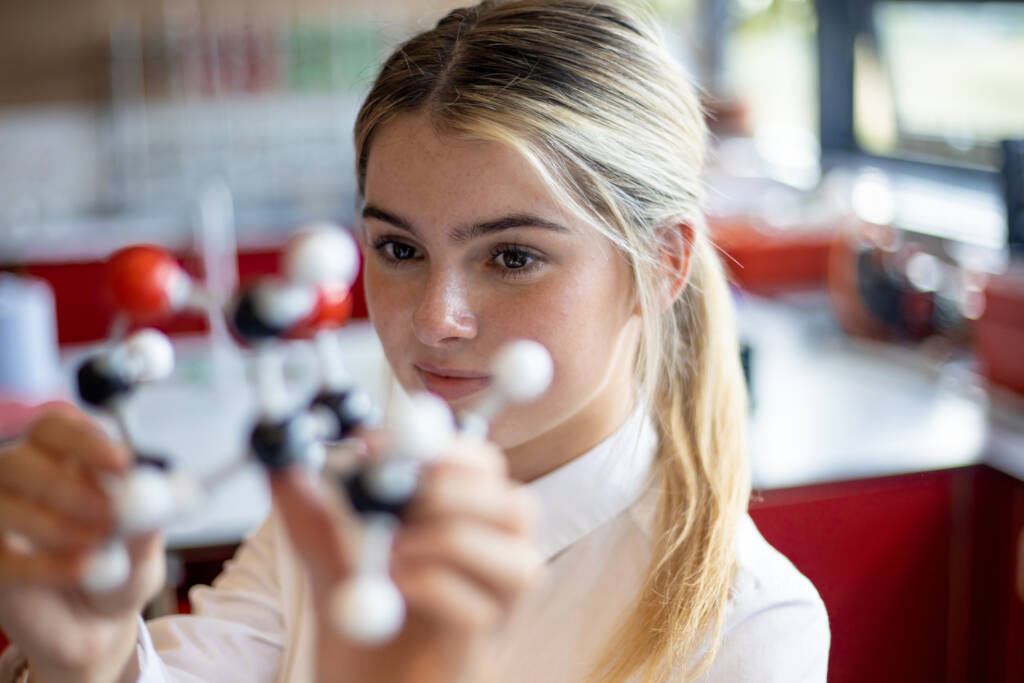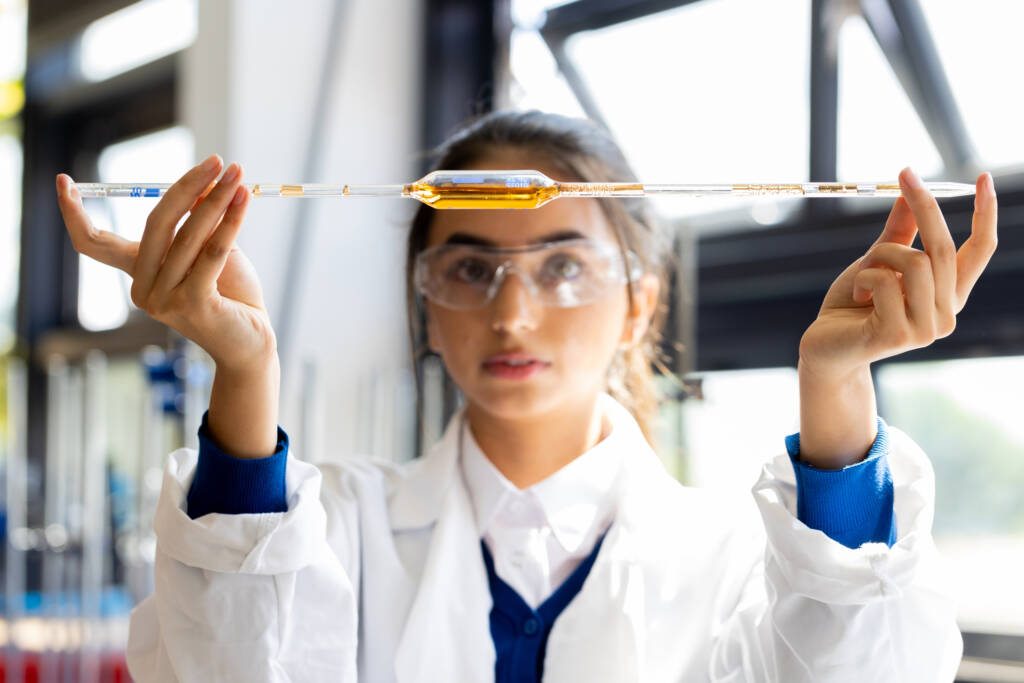
Physical Science (lab)/Physical Science Honors (lab)

This two-segment course is designed as an interactive introduction to basic physics and chemistry. Topics include forces and motion, energy through waves, electricity, magnetism, the matter around us, chemical bonding, and reactions. This course is designed to serve as a foundation for the study of the physical sciences. Students use scientific inquiry and higher-order problem-solving as they explore these topics through interactive simulations and both virtual and hands-on experiences. In addition, technology, engineering, and mathematics (STEM) concepts are integrated throughout the course. Collaborative projects and real-world aid the student in ultimately demonstrating an understanding of the importance of the physical and chemical properties of the world around them.
Major Topics and Concepts
Module 1
- Motion Pretest
- The Study of Science
- Speed, Velocity, and Acceleration
- Honors: Speed, Velocity, and Acceleration
- The Laws of Motion
- Honors: The Laws of Motion
- Forces in Action
- Energy
- Work and Power
- Motion Discussion-Based Assessment
- Motion Exam
Module 2
- Waves Pretest
- Waves
- Sound
- Honors: Sound
- The Electromagnetic Spectrum — The Visible
- The Electromagnetic Spectrum — The Non–Visible
- Science and You
- Waves Discussion-Based Assessment
- Waves Exam
Module 3
- Electricity Pretest
- Electrical Charges
- Electric Current
- Circuits
- Electromagnetism
- Energy Resources
- Human Impacts on the Environment
- Electricity Discussion-Based Assessment
- Electricity Exam
- Segment One Exam
Module 4
- Classifying Matter Pretest
- States of Matter
- Classifying Matter
- Properties of Matter
- Atomic Theory
- Honors: Atomic Theory
- Properties of Atoms
- The Periodic Table of Elements
- Classifying Matter Discussion-Based Assessment
- Classifying Matter Exam
Module 5
- Chemical Properties Pretest
- Electrons and Bonding
- Ionic and Covalent Bonds
- Chemical Formulas
- Hydrogen Hydroxide
- Acids and Bases
- Lab Time: Acid and Base Indicators
- Chemical Properties Discussion-Based Assessment
- Chemical Properties Exam
Module 6
- Reactions Pretest
- Chemical Reactions
- Classifying Chemical Reactions
- Chemical Reactions and Energy
- Honors: Chemical Reactions and Energy
- Reaction Rates and Temperature Laboratory
- Radioactivity
- Nuclear Reactions
- Honors: Regulating Nuclear Power
- Impact of Biotechnology
- Reactions Discussion-Based Assessment
- Reactions Exam
*Collaborative project: Students are required to submit one collaborative project in segment 2. There will be three different options throughout the segment to choose from.
Competencies
Motion
Students will demonstrate an understanding of motion by describing elements of motion, explaining forces and friction, describing momentum, and differentiating forms of energy.
Waves
Students will demonstrate an understanding of waves by summarizing the properties of waves, describing characteristics of mechanical waves, and explaining components of electromagnetic waves.
Electricity
Students will demonstrate an understanding of electricity by describing electrical charges, describing electrical current and circuits, explaining electromagnetism, and comparing energy resources.
Classifying Matter
Students will demonstrate an understanding of classifying matter by explaining the states of matter, describing properties of matter, and describing the properties of atoms.
Chemical Properties
Students will demonstrate an understanding of chemical properties by relating electrons and bonding, explaining chemical formulas, and describing properties of acids and bases.
Chemical Reactions
Students will demonstrate an understanding of chemical reactions by describing chemical reaction classification, explaining energy and reaction rates, and describing radioactivity.
Projects allow students to demonstrate competence and understanding of concepts and skills by completing a career-related task. For example, the assignment might be to create a mural, a package design, a speech, a film review, or a movie set – you name it! These creative projects are about applying your learning acquired through in-depth research to real-world career tasks.
Each competency will be addressed through a project that is based on a real-life career task. Here are the careers you will explore: Wildland Firefighter, Reporter, Electromechanical Engineer, Science Editor, Soil Scientist, and Occupational Health and Safety Specialist.
Projects
Competencies
Motion
Students will demonstrate an understanding of motion by describing elements of motion, explaining forces and friction, describing momentum, and differentiating forms of energy.
Waves
Students will demonstrate an understanding of waves by summarizing the properties of waves, describing characteristics of mechanical waves, and explaining components of electromagnetic waves.
Electricity
Students will demonstrate an understanding of electricity by describing electrical charges, describing electrical current and circuits, explaining electromagnetism, and comparing energy resources.
Classifying Matter
Students will demonstrate an understanding of classifying matter by explaining the states of matter, describing properties of matter, and describing the properties of atoms.
Chemical Properties
Students will demonstrate an understanding of chemical properties by relating electrons and bonding, explaining chemical formulas, and describing properties of acids and bases.
Chemical Reactions
Students will demonstrate an understanding of chemical reactions by describing chemical reaction classification, explaining energy and reaction rates, and describing radioactivity.
Experiences allow you to explore a career field you’re curious about while mastering competencies for school credit. Through career-focused experiential learning, you will develop and learn skills for application to tasks typically completed as part of a career rather than using traditional assessments like essays or tests. During your Experience, you’ll work with a professional in the field to support your learning whom we call an “outside expert.” You’ll earn a badge for your accomplishments to share on social media and higher education platforms, or with colleges, potential employers, peers, and colleagues to display your qualifications.
Here’s how experiences work:
- Each competency you work on is addressed through a separate deliverable predetermined by you and your instructor.
- Guided learning for each module consists of research and/or work with a professional in the field. Your instructor will coach you through this process.
- Each module culminates in a final demonstration of understanding, which includes a deliverable and a discussion-based assessment with your instructor.
Here’s an example:
Let’s say you’re curious about a career in healthcare. You decide you’d like to learn about this career area, make a professional connection, earn a badge, and meet competencies for your 9th-grade English requirement. While enrolled in English 1 Experiences, you conduct research to better understand language and structure in writing. Then you may work with an Occupational Therapist to help apply your writing skills to create an informational video about adaptive equipment for patients. The video aims to advise family members of patients regarding the use of accommodations and equipment to help patients perform daily tasks. Now you’ve earned the Language and Structure in Writing competency! This is just one example of the many ways Experiences can bridge competencies to careers.
Obtaining an Outside Expert: Prior to enrollment, please have an idea for an outside expert in mind or consult with our counseling department by emailing [email protected] for help in identifying one.
*A parent/guardian permission form and background check of the outside expert are both required to work with outside experts without parental supervision.
Competencies
Motion
Students will demonstrate an understanding of motion by describing elements of motion, explaining forces and friction, describing momentum, and differentiating forms of energy.
Waves
Students will demonstrate an understanding of waves by summarizing the properties of waves, describing characteristics of mechanical waves, and explaining components of electromagnetic waves.
Electricity
Students will demonstrate an understanding of electricity by describing electrical charges, describing electrical current and circuits, explaining electromagnetism, and comparing energy resources.
Classifying Matter
Students will demonstrate an understanding of classifying matter by explaining the states of matter, describing properties of matter, and describing the properties of atoms.
Chemical Properties
Students will demonstrate an understanding of chemical properties by relating electrons and bonding, explaining chemical formulas, and describing properties of acids and bases.
Chemical Reactions
Students will demonstrate an understanding of chemical reactions by describing chemical reaction classification, explaining energy and reaction rates, and describing radioactivity.

